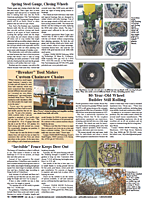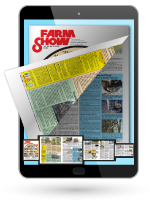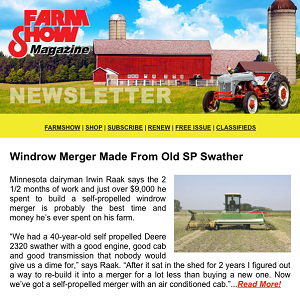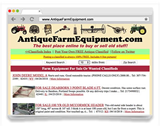Rollers Smash Stalks, Save Tires
BT corn isn't just rough on pests; it rips up tires, too. After replacing tires on his International Harvester 1640 combine in mid season a year ago, Dwight Ruhlen hated to see one of the new tires lose a cleat before harvest had even ended.
"I have a neighbor, Jeff Cail, who does welding. I took the header over and told him what I wanted and where it needed to go," says Ruhlen.
He wanted rollers that would knock the stubble over before it tore up tires. Cail put together two frameworks with bar springs, bearings, brackets and rollers. He mounted them on the rear of the header directly ahead of the tires.
Each steel roller is 10 1/2 in. wide and 8 1/2 in. in diameter and made from 1/2-in. well casing. Plates welded to the ends enclose the casing with a 16-in. long, 1 1/2-in. shaft extending through the centers. To give the rollers extra crushing power, Cail filled them with sand.
The roller shaft fits 4 5/8-in. bearings that are bolted to 4 by 6-in. plates. The plates in turn are welded to the ends of two bar springs mounted to the header frame. A 14-in. piece of 2-in. angle iron welded to the two bar springs adds stability and prevents them spreading apart under pressure. Finally Cail welded the ends of a length of chain to the end of each bar spring and bolted it to another bar on the back of the header.
"The chains keep the roller from going back under the header if the combine backs up when the header is down," explains Ruhlen. "The bar spring gives the rollers some flexibility if they hit a rock or other object."
The rollers cost Ruhlen about $400. After one season of use, he's confident they were a good investment, especially with tires that cost $1,200 each to replace.
Contact: FARM SHOW Followup, Dwight Ruhlen, 2591 Halcyondale Rd., Sylvania, Ga. 30467 (ph 912 863-4398).

Click here to download page story appeared in.
Click here to read entire issue
Rollers Smash Stalks, Save Tires COMBINES Accessories 31-6-17 BT corn isn't just rough on pests; it rips up tires, too. After replacing tires on his International Harvester 1640 combine in mid season a year ago, Dwight Ruhlen hated to see one of the new tires lose a cleat before harvest had even ended.
"I have a neighbor, Jeff Cail, who does welding. I took the header over and told him what I wanted and where it needed to go," says Ruhlen.
He wanted rollers that would knock the stubble over before it tore up tires. Cail put together two frameworks with bar springs, bearings, brackets and rollers. He mounted them on the rear of the header directly ahead of the tires.
Each steel roller is 10 1/2 in. wide and 8 1/2 in. in diameter and made from 1/2-in. well casing. Plates welded to the ends enclose the casing with a 16-in. long, 1 1/2-in. shaft extending through the centers. To give the rollers extra crushing power, Cail filled them with sand.
The roller shaft fits 4 5/8-in. bearings that are bolted to 4 by 6-in. plates. The plates in turn are welded to the ends of two bar springs mounted to the header frame. A 14-in. piece of 2-in. angle iron welded to the two bar springs adds stability and prevents them spreading apart under pressure. Finally Cail welded the ends of a length of chain to the end of each bar spring and bolted it to another bar on the back of the header.
"The chains keep the roller from going back under the header if the combine backs up when the header is down," explains Ruhlen. "The bar spring gives the rollers some flexibility if they hit a rock or other object."
The rollers cost Ruhlen about $400. After one season of use, he's confident they were a good investment, especially with tires that cost $1,200 each to replace.
Contact: FARM SHOW Followup, Dwight Ruhlen, 2591 Halcyondale Rd., Sylvania, Ga. 30467 (ph 912 863-4398).
To read the rest of this story, download this issue below or click
here to register with your account number.








